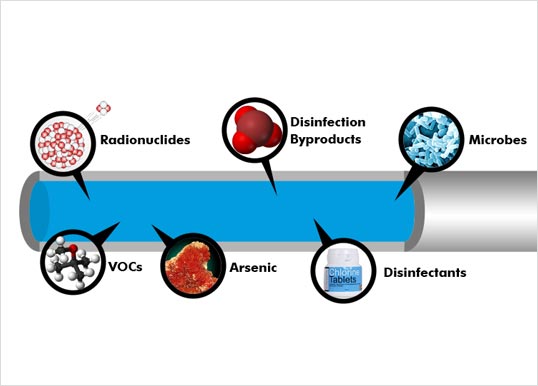Water Borne Diseases
More than 70% of known diseases are water born. Therefore, we should take special care in water purification technologies/qualities to ensure safe & healthy drinking water.
The infected water causes many problems. Some of them are of immediate effect normally caused by water born bacteria, germs, and viruses such as diseases like jaundice, encephalitis, typhoid, anaemia, and cholera, E-coli, Flue, Hepatitis A, Flue, E-coli, filariasis and much more.
Contaminated water with arsenic, bromide, mercury, fluoride, lead etc. causes many problems in long run. Some of them are skin diseases, cancer, cardiac problem, hypertension, skin diseases, arthritis, skin crackage problem etc. and much more.
Likewise excessive hard water or low mineral water or acidic or high pH drinking water causes many problems. Some of them are early ageing, lower limbs pain, obesity, diabetes, arthritis, constipation, hypertension, hair fall, skin dullness, acidity, gassy stomach, slow metabolism, weak immune system, bad cholesterol, cardiac problem and much more.
Please note, the above informed diseases are also associated with daily life style, habits, cleanliness and number of other factors but contaminated water/infected water may be one of them. Water is not only compulsory reason.
As per WHO, arsenic level in drinking water should not exceed 0.1 mg per litre. Unfortunately due to
excessive use of pesticide/chemicals in agriculture, the ground water in India mostly contaminated with
high level of arsenic, lead, pesticides, mercury, fluoride etc. Today almost every household uses
overhead tank that may have infected. In case of corporation supply water, there is also chances of
mixing of the impurities due to pipeline leakage and other factors.
Harmful Contaminants/Germs in water
Arsenic, Fluoride, Bromide, mercury, Cyanide, lead, excess calcium, excess magnesium, excess sodium, chlorine, Aluminium, Ammonia, Barium, pesticides, herbicides, chloramines, cadmium, excess copper, nitrates/nitrites, radium, selenium, uranium etc. are some of the harmful contaminants found in water. And molecule sizes area greater than 0.01 microns.
E-Coli, HAV, water borne bacteria, protozoa, viruses like rota, sapo etc are more common and size ranging from 0.03 microns to 5.0 microns.
The typical size of a TDS molecule is less than 0.0009 microns, and it can split even smaller and water molecule size is 0.000283 microns.
The pore size of the RO membrane is 0.0001 microns, while the pore size of the NF membrane ranges from 0.0015 to 0.0002 microns (depending on version). As a result, pollutants and impurities cannot flow through an NF or RO membrane but are flushed through rejected water. However, these tasks cannot be effectively performed by the UF membrane or Micro filter membrane.
Arsenic level is found more than the accepted level in most of the area of India. This is due to
increasing use of pesticides and chemicals in agriculture and pollution in our surroundings. Arsenic is
serious threat to our health causing cancer, diabetes, cardiovascular problems, skin disease, and other
dangerous diseases.
References :



To understand the consequences of contaminated water please visit the links below:

Arsenic is a natural component of the earth’s crust and is widely distributed throughout the environment in the air, water and land. It is highly toxic in its inorganic form.

Committed to building a better, healthier future for the nearly two billion people in the Region

Arsenic levels in water have been as high as 3,880 parts per billion in parts of the state. Pollution standards cite 50 parts per billion as harmful.

Microbial and organic contaminants cannot always be detected by human senses. You might go years before realizing a problem exists.
Important Notes:
Size details in micron:
- Water molecule size 0.000282 µ,
- water born virus & germs size lies between 0.027 µ to 5 µ,
- Arsenic, fluoride, bromide, cyanide, lead etc. molecule sizes remains > 0.01 microns
- (Dissolved Minerals) Sodium, calcium, magnesium etc molecule size < 0.0009 microns
- UF Membrane (hollow fibre with good quality) pore size 1 µ,
- Micro Filtration Membrane pore size 0.01 µ,
- KNL-NF20 Membrane pore size 0.0015 µ
- KNL-NF40 Membrane pore size 0.0010 µ
- KNL-NF60 Membrane pore size 0.0005 µ
- KNL-NF80 Membrane pore size 0.0002 µ
- RO membrane pore size 0.0001 µ
Please note the water hardness rejections rate may vary by ± 5% depends on water hardness compositions molecular weight, sizes and inlet pressure inside membrane housing.
Important Disclaimer: Information provided on KNL Trading Co. website is for general informational and educational purposes only, it is not offered as and does not constitute medical advice. Any of the materials presented is not meant to be a substitute for professional medical care or attention by a qualified practitioner, nor should they be construed as such. Any third party offering or advertising on this website does not constitute an endorsement by KNL Trading Co. Please report outdated or inaccurate information if any.